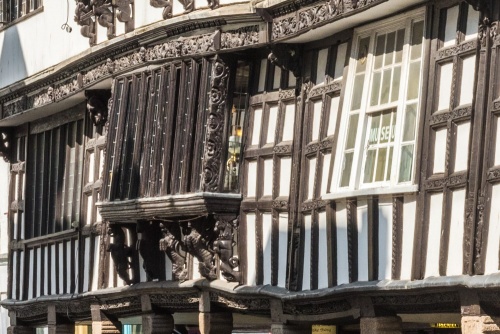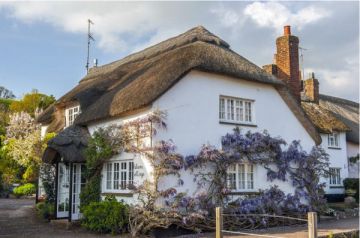
Dartmouth Museum is a fascinating museum of local life and heritage, housed in the Butterwalk, a picturesque timber-framed merchant's house built between 1635 and 1640.
The Butterwalk was built on land reclaimed from the estuary. The soft soil on the reclaimed land resulted in shifting foundations over time so that today the Butterwalk is a wonderfully quirky example of a 'black and white' building with sloping floors and crooked doorways.

The King's Room
Though the entire museum building is of great historical interest, one room, in particular, draws the attention of most visitors. That is the King's Room, so named for its links to King Charles II. The king's ship was forced to put into Dartmouth in 1671 due to a severe storm. The king and his royal entourage were hosted here, in what was considered the best room in town. One reminder of the visit is a painted and gilded royal coat of arms over the fireplace.
The King's room acts as a display area for a large number of ship models covering the rich maritime history of Dartmouth. The centrepiece is an exceptionally detailed model of the 1782 24-gun sloop HMS Echo. Around the walls of the room are models following a timeline, beginning with an early medieval Crusader warship. Next is a 14th-century 'cog' similar to the one used by John Hawley, a privateer and 14-times Mayor of Dartmouth.
Then there is a model of the Mayflower that took the Pilgrim Fathers to America. The Pilgrims were forced to put in to Dartmouth for repairs to the Mayflower's sister ship, the Speedwell.

Another highlight is a model of a man-of-war built by French prisoners of war during the Napoleonic Wars. There are also a large number of ships-in-bottles and naval paintings.
The Henley Study
From the King's Room you go on to The Henley Study, portraying the Victorian study of William Cumming Henley (1860-1916). By trade an ironmonger, Henley had an insatiable curiosity and amassed a remarkable science and natural history collection. See also his hand-drawn product catalogue of water closets for sale. One notable object is a Coco de Mer, a bi-lobed nut popularly believed to come from trees growing on the sea bed.

The Holdsworth Room
This room covers the social history of Dartmouth and is named for one of the town's leading Victorian families. See traditional costumes and a 19th-century doll's house. The town's medieval stocks and pillory are on display as well as the lock and key from the town gaol.
Adjoining the Holdsworth Room is an exhibition on Dartmouth's links to the D-Day invasion. Four hundred and eighty five vessels based in the River Dart took place in the D-Day landings. In the reception area is a set of 16 embroidery panels illustrating D-Day preparations in Dartmouth.
Ask at reception to see the 17th-century Tree of Jesse Ceiling, a nationally-important plasterwork ceiling preserved in an area of the Butterwalk not normally open to the public.

Dartmouth Museum is one of those wonderful places where the history of a place is illustrated in a historic building that deserves attention in its own right. Our family had an extremely good time exploring the museum, especially the exceptional collection of model ships in the King's Room.
Dartmouth Museum is located in the historic Butterwalk on Duke Street, just off the Quay and a stone's throw from Dartmouth Harbour and the Embankment. Parking can be a challenge near the waterfront in Dartmouth, so we recommend using the park and ride scheme.
About Dartmouth Museum
Address: Duke Street,
Dartmouth,
Devon,
England, TQ6 9PZ
Attraction Type: Museum
Location: On the corner of Duke Street and The Quay.
Website: Dartmouth Museum
Email: dartmouth@devonmuseums.net
Location
map
OS: SX877514
Photo Credit: David Ross and Britain Express
POPULAR POSTS
HERITAGE
 We've 'tagged' this attraction information to help you find related historic attractions and learn more about major time periods mentioned.
We've 'tagged' this attraction information to help you find related historic attractions and learn more about major time periods mentioned.
Find other attractions tagged with:
NEARBY HISTORIC ATTRACTIONS
Heritage Rated from 1- 5 (low to exceptional) on historic interest
Dartmouth, St Saviour's Church - 0.1 miles (Historic Church) ![]()
Bayard's Cove Fort - 0.3 miles (Historic Building) ![]()
Dartmouth Castle - 0.8 miles (Castle) ![]()
Gallants Bower Fort - 0.8 miles (Historic Building) ![]()
Dartmouth, St Petrox Church - 0.9 miles (Historic Church) ![]()
Coleton Fishacre House and Garden - 1.9 miles (Historic House) ![]()
Greenway - 2.3 miles (Historic House) ![]()
Stoke Gabriel Church - 4 miles (Historic Church) ![]()













